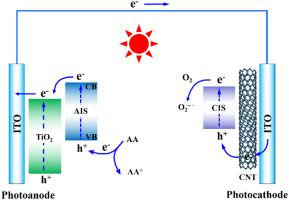Analytica Chimica Acta ( IF 6.2 ) Pub Date : 2022-11-05 , DOI: 10.1016/j.aca.2022.340593 Yibin Lu 1 , Yaqun Xu 1 , Tongtong Ding 1 , Caifeng Ding 1 , Gao-Chao Fan 1 , Xiliang Luo 1

|
Photocathodic immunosensors generally exhibit fortified anti-interference abilities than photoanodic ones against the detection in biological specimens. Yet, the weak photocurrent signals of the photocathodes have limited evidently the detection performance. Herein, an efficient and feasible photoelectrochemical (PEC) immunosensor was developed on the basis of the featured photocathode-photoanode operating system. In the proposal, the elaborated PEC immunosensor integrated photocathode with photoanode, and the immune recognition occurred just on the photocathode. To illustrate the performance, α-fetoprotein (AFP) was selected as a target antigen (Ag) for detection. TiO2 nanoparticles were decorated with AgInS2 quantum dots (AIS QDs) to fabricate the TiO2/AIS photoanode, and the carbon nanotubes (CNTs) were modified with CuInS2 nanoflowers (CIS NFs) to prepare the CNT/CIS photocathode for the capture AFP antibody (Ab) anchoring. Target Ag detection depended on significant decrease of the photocurrent signal produced by large steric hindrance of the captured AFP molecules. Coupling excellent photoelectric property with anti-interference ability in this elegant PEC immunosensor, sensitive and specific probing of target Ag was realized. The proposed photocathode-photoanode integrating strategy provides a promising way to explore other high-performance PEC immunosensors against the detection in biological matrixes.
中文翻译:

基于特色光电阴极-光电阳极操作系统的高性能光电化学免疫传感器
光电阴极免疫传感器通常表现出比光电阳极更强的抗干扰能力,以对抗生物标本的检测。然而,光电阴极微弱的光电流信号明显限制了检测性能。在此,基于特色的光电阴极-光电阳极操作系统开发了一种高效可行的光电化学(PEC)免疫传感器。在该提案中,精心制作的PEC免疫传感器将光电阴极与光电阳极集成在一起,免疫识别仅发生在光电阴极上。为了说明性能,选择甲胎蛋白 (AFP) 作为目标抗原 (Ag) 进行检测。用 AgInS 2量子点 (AIS QDs)装饰TiO 2纳米粒子以制备 TiO 2/AIS 光电阳极和碳纳米管 (CNT) 用 CuInS 2纳米花 (CIS NF) 进行修饰,以制备用于捕获 AFP 抗体 (Ab) 锚定的 CNT/CIS 光电阴极。目标 Ag 检测取决于捕获的 AFP 分子的大空间位阻产生的光电流信号的显着减少。这种优雅的 PEC 免疫传感器将优异的光电性能与抗干扰能力相结合,实现了对目标 Ag 的灵敏和特异性探测。所提出的光电阴极-光电阳极集成策略为探索其他针对生物基质检测的高性能 PEC 免疫传感器提供了一种有前途的方法。


























 京公网安备 11010802027423号
京公网安备 11010802027423号